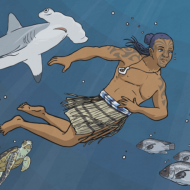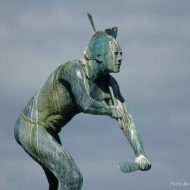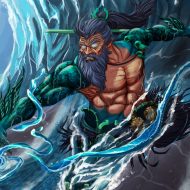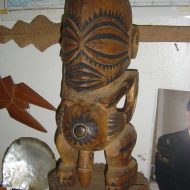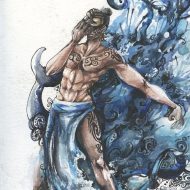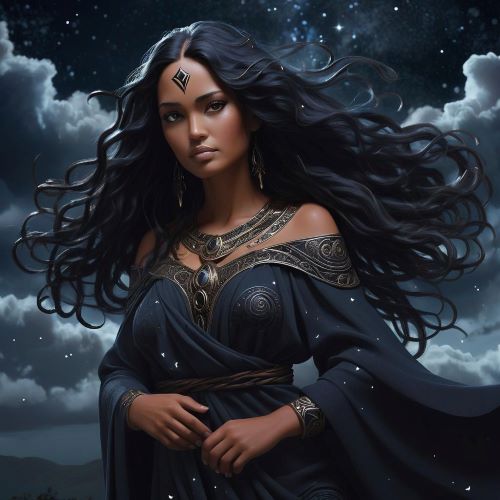Tangaroa : God of the Sea
Listen
At a glance
| Description | |
|---|---|
| Origin | Maori Mythology |
| Classification | Gods |
| Family Members | Ranginui (Father), Papatūānuku (Mother), Rongo, Tū, Haumia, Tāne, Tāwhirimātea (Siblings), Punga (Son) |
| Region | New Zealand |
| Associated With | Sea, Oceans, Marine Life |
Tangaroa
Introduction
Tangaroa, hailed as the paramount deity of the sea, commands unparalleled authority over the ocean, regarded as the genesis and embodiment of all marine existence. In the lore of Maori and Polynesian mythology, Tangaroa’s origins precede the dawn of human civilization, elevating him to a venerable and revered status among the divine. As the personification of the boundless might and capricious temperament of the sea, Tangaroa transcends mere deity status to become a formidable elemental force—a primordial essence that both sustains and challenges humanity. From his aqueous domain, he presides over the ebb and flow of the tides, governs the myriad creatures that inhabit its depths, and shapes the very fabric of existence itself. His sway extends across the expansive expanse of the ocean, imprinting upon the lives and spiritual convictions of the Maori populace inhabiting the archipelago of New Zealand.
Physical Traits
Tangaroa’s portrayal in mythology often aligns with that of a whale, embodying the grand atua, or deity, of the sea, lakes, rivers, and the creatures dwelling within, particularly fish. Under the guise of Tangaroa-whakamau-tai, he commands authority over the tides, dictating their rhythmic movements. Although no single definitive image of Tangaroa prevails, depictions vary among different iwi (tribes) and pūrākau (stories). Frequently, he emerges as a formidable humanoid figure, his complexion reminiscent of the ocean’s profound depths, adorned with strands of seaweed and shells. In certain traditions, he assumes the majestic form of a whale, emblematic of his dominion over the ocean’s abyssal expanses. Some narratives depict him with eight arms, symbolizing the myriad currents and forces orchestrating the sea’s dynamics. Irrespective of the specific portrayal, Tangaroa’s essence conjures feelings of boundless power, expansive vastness, and enigmatic allure.
Family
Tangaroa emerges as a pivotal figure in the cosmogony, being a progeny of Ranginui, the Sky Father, and Papatūānuku, the Earth Mother. Following the tumultuous separation of their celestial parents alongside his siblings—Rongo, Tū, Haumia, and Tāne—Tangaroa finds himself targeted by his brother Tāwhirimātea, the deity of storms, compelling him to seek sanctuary beneath the waves. As the progenitor of numerous marine creatures, Tangaroa’s lineage extends through his son Punga, who begets two notable offspring: Ikatere, the progenitor of fish, and Tū-te-wehiwehi (or Tū-te-wanawana), the progenitor of reptiles.
Embedded within the fabric of the universe’s genesis narrative, Tangaroa’s role resonates deeply. In the most prevalent rendition, he emerges as one of the offspring of Ranginui and Papatūānuku, whose entwined embrace stifled the emergence of life. Fueled by the primal urge for growth and illumination, Tangaroa and his brethren orchestrate the violent separation of their parents, birthing the expanse necessary for existence. Yet, their actions provoke the wrath of Tāwhirimātea, whose tempestuous fury reshapes the landscape in perpetuity. Seeking solace from his vengeful sibling, Tangaroa retreats to the ocean’s depths, asserting his dominion as its undisputed sovereign.
Diverse iterations of the creation saga offer varied perspectives on Tangaroa’s role. Some narratives depict him not as Papatūānuku’s offspring, but as her spouse. Furthermore, the specifics of his offspring and lineage fluctuate across interpretations. Nevertheless, Tangaroa’s steadfast connection to the sea and its denizens remains unwavering.
Other names
Tangaroa, the revered deity of the sea in Maori mythology, is known by several names that reflect different aspects of his power and influence. Among these appellations are Tangaroa-whakamau-tai, emphasizing his command over the tides, and Tangaroa-a-timu, linking him to the ebbing tide. These names underscore the intricate relationship between Tangaroa and the rhythmic movements of the ocean, highlighting his role as both master and guardian of its vast expanse.
In Maori tradition, Tangaroa is also recognized by other titles that offer insights into his multifaceted nature. Tangaroa-maui symbolizes his role as the provider of sustenance, while Te Potaka represents the mysterious depths of the ocean. Additionally, his name varies across regions, with Takaroa being used in the dialect of the South Island. Together, these names and titles enrich the mythology surrounding Tangaroa, painting a vivid portrait of a deity whose presence permeates every aspect of the marine realm, from the gentle ebb and flow of the tides to the hidden mysteries lurking in its darkest depths.
Powers and Abilities
Tangaroa’s dominion over the ocean extends beyond mere authority; he is revered as the very genesis and essence of all marine existence. Under the mantle of Tangaroa-whakamau-tai, he wields mastery over the ebb and flow of the tides, serving as their arbiter and custodian. Moreover, Tangaroa assumes the role of protector, safeguarding the sea and its myriad inhabitants across numerous traditions, where the ocean is often regarded as the cradle of life itself. As the sovereign ruler of the oceanic realm, Tangaroa commands unparalleled power, directing the rhythmic dance of the tides, summoning tempests, and governing the diverse array of creatures that populate his domain.
In tales passed down through generations, Tangaroa’s influence extends to the very origins of sea life, with some narratives attributing the creation of fish and other marine beings directly to him. Furthermore, Tangaroa’s association with fertility and abundance underscores the life-affirming potential inherent in the oceanic depths. However, like the ever-changing temperament of the sea, Tangaroa’s power embodies both tranquility and ferocity. While he bestows sustenance and prosperity, he is also capable of unleashing devastating storms, exemplifying the dual nature of his dominion and the eternal ebb and flow of existence itself.
Modern Day Influence
Despite the pervasive influence of Western culture, the Maori community has admirably preserved its ancestral beliefs and customs. Tangaroa remains a prominent and revered figure in modern Maori society, continuing to inspire various forms of artistic expression such as art, music, and dance. In regions like Rarotonga, Tangaroa holds sway as both the deity of the sea and fertility, with intricately carved wooden figures depicting his likeness adorning local artifacts and cultural artifacts. His iconic image graces a plethora of mediums, from traditional carvings and paintings to contemporary tattoos, serving as a poignant symbol of enduring cultural significance.
Furthermore, Tangaroa’s name resonates beyond mere artistic representation, extending its influence to various facets of contemporary life. It embellishes the hulls of ships, serves as a rallying cry for conservation organizations, and fuels environmental movements dedicated to preserving the oceanic realm. Additionally, age-old customs such as sustainable fishing practices and the offering of prayers, or karakia, in homage to Tangaroa endure to this day, nurturing a collective ethos of stewardship and reverence toward the marine environment. Through these continued practices and expressions, the Maori people reaffirm their profound connection with Tangaroa and their enduring commitment to honoring and safeguarding the natural world.
Related Images
Frequently Asked Questions
What is lorem Ipsum?
I am text block. Click edit button to change this text. Lorem ipsum dolor sit amet, consectetur adipiscing elit. Ut elit tellus, luctus nec ullamcorper mattis, pulvinar dapibus leo.
What is lorem Ipsum?
I am text block. Click edit button to change this text. Lorem ipsum dolor sit amet, consectetur adipiscing elit. Ut elit tellus, luctus nec ullamcorper mattis, pulvinar dapibus leo.
What is lorem Ipsum?
I am text block. Click edit button to change this text. Lorem ipsum dolor sit amet, consectetur adipiscing elit. Ut elit tellus, luctus nec ullamcorper mattis, pulvinar dapibus leo.
What is lorem Ipsum?
I am text block. Click edit button to change this text. Lorem ipsum dolor sit amet, consectetur adipiscing elit. Ut elit tellus, luctus nec ullamcorper mattis, pulvinar dapibus leo.
What is lorem Ipsum?
I am text block. Click edit button to change this text. Lorem ipsum dolor sit amet, consectetur adipiscing elit. Ut elit tellus, luctus nec ullamcorper mattis, pulvinar dapibus leo.

